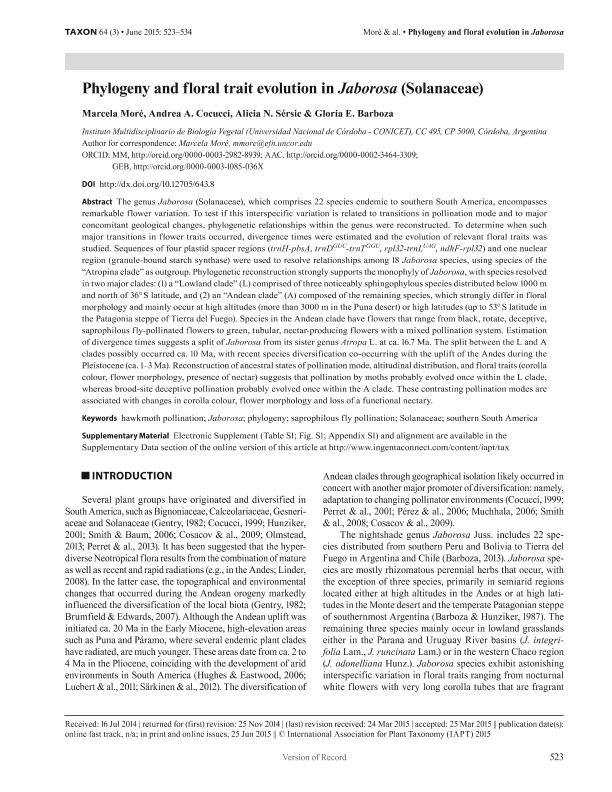Artículo
Phylogeny and floral trait evolution in Jaborosa (Solanaceae)
Fecha de publicación:
06/2015
Editorial:
International Association for Plant Taxonomy
Revista:
Taxon
ISSN:
0040-0262
e-ISSN:
1996-8175
Idioma:
Inglés
Tipo de recurso:
Artículo publicado
Clasificación temática:
Resumen
The genus Jaborosa (Solanaceae), which comprises 22 species endemic to southern South America, encompasses remarkable flower variation. To test if this interspecific variation is related to transitions in pollination mode and to major concomitant geological changes, phylogenetic relationships within the genus were reconstructed. To determine when such major transitions in flower traits occurred, divergence times were estimated and the evolution of relevant floral traits was studied. Sequences of four plastid spacer regions (trnH-pbsA, trnDGUC -trnTGGU , rpl32-trnLUAG , ndhF-rpl32) and one nuclear region (granule-bound starch synthase) were used to resolve relationships among 18 Jaborosa species, using species of the “Atropina clade” as outgroup. Phylogenetic reconstruction strongly supports the monophyly of Jaborosa, with species resolved in two major clades: (1) a “Lowland clade” (L) comprised of three noticeably sphingophylous species distributed below 1000 m and north of 36° S latitude, and (2) an “Andean clade” (A) composed of the remaining species, which strongly differ in floral morphology and mainly occur at high altitudes (more than 3000 m in the Puna desert) or high latitudes (up to 53° S latitude in the Patagonia steppe of Tierra del Fuego). Species in the Andean clade have flowers that range from black, rotate, deceptive, saprophilous fly-pollinated flowers to green, tubular, nectar-producing flowers with a mixed pollination system. Estimation of divergence times suggests a split of Jaborosa from its sister genus Atropa L. at ca. 16.7 Ma. The split between the L and A clades possibly occurred ca. 10 Ma, with recent species diversification co-occurring with the uplift of the Andes during the Pleistocene (ca. 1–3 Ma). Reconstruction of ancestral states of pollination mode, altitudinal distribution, and floral traits (corolla colour, flower morphology, presence of nectar) suggests that pollination by moths probably evolved once within the L clade, whereas brood-site deceptive pollination probably evolved once within the A clade. These contrasting pollination modes are associated with changes in corolla colour, flower morphology and loss of a functional nectary.
Palabras clave:
Hawkmoth Pollination
,
Jaborosa
,
Phylogeny
,
Saprophilous Fly Pollination
Archivos asociados
Licencia
Identificadores
Colecciones
Articulos(IMBIV)
Articulos de INST.MULTIDISCIPL.DE BIOLOGIA VEGETAL (P)
Articulos de INST.MULTIDISCIPL.DE BIOLOGIA VEGETAL (P)
Citación
More, Marcela; Cocucci, Andrea Aristides; Sersic, Alicia Noemi; Barboza, Gloria Estela; Phylogeny and floral trait evolution in Jaborosa (Solanaceae); International Association for Plant Taxonomy; Taxon; 64; 3; 6-2015; 523-534
Compartir
Altmétricas




